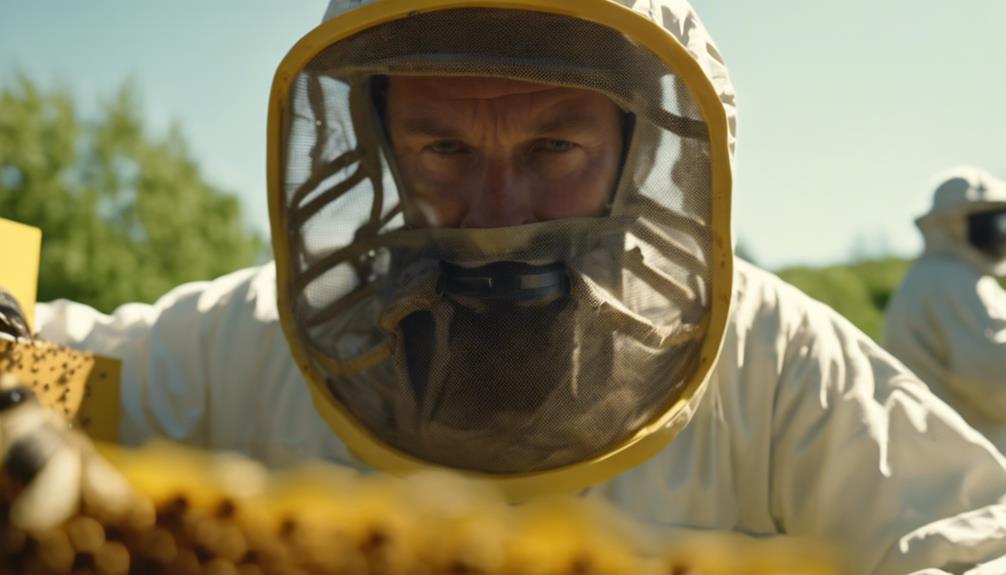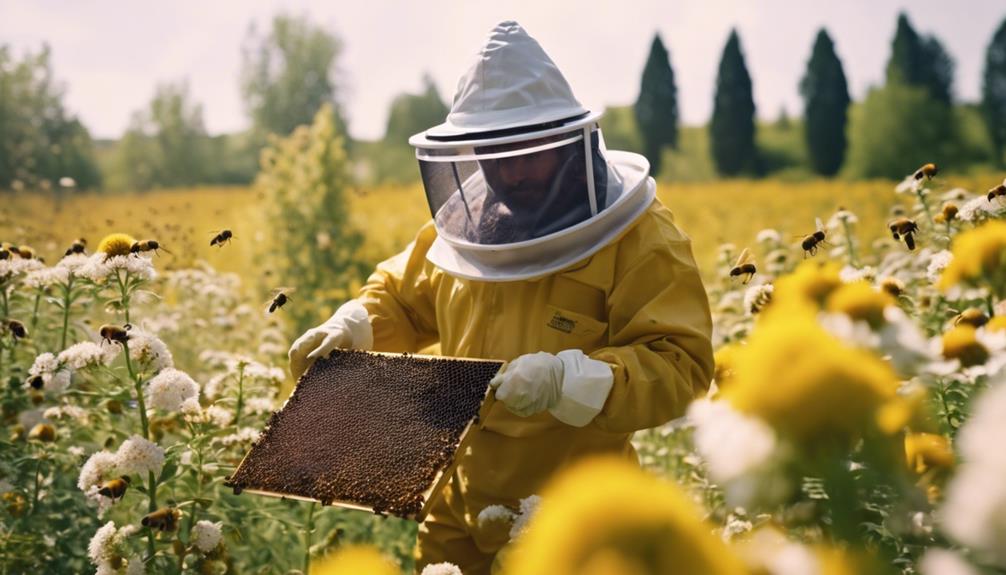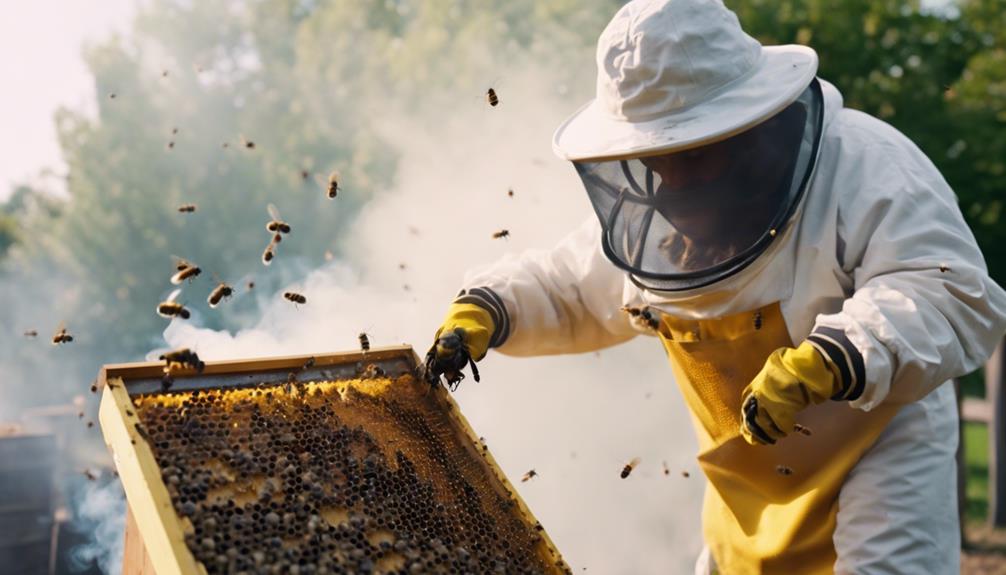Beekeeping can indeed require some time commitment as managing hives typically takes around 30-45 minutes per week. Learning the ropes of beekeeping is essential for success, ensuring bountiful honey harvests and keeping bees healthy and productive. Regular hive inspections and maintenance are crucial, especially during spring and harvest times when demands are higher. However, finding a rhythm that fits your schedule can make this fulfilling hobby manageable. The sweet rewards of honey production and the engaging experiences with bees and nature make the time input well worth it.
If you’re curious to learn more about the seasonal demands, impact on neighbors, and financial aspects of beekeeping, there’s plenty more to discover!
Main Points
- Beekeeping requires 30-45 minutes per week.
- Learning beekeeping is essential for success.
- Regular maintenance keeps bees healthy and productive.
- Understanding seasonal demands is crucial.
- Dedication to bees is fulfilling and enriching.
Time Commitment in Beekeeping
For those considering beekeeping, the time commitment involved in managing hives is typically around 30-45 minutes per week for routine checks and maintenance.
Learning the ins and outs of beekeeping is essential for success. While it may seem like a significant time investment, the rewards are sweet. Taking the time to care for your bees not only guarantees their well-being but also leads to a bountiful harvest of delicious honey.
Regular maintenance and inspections are key to keeping your bees healthy and productive. As we explore the world of beekeeping, we discover that dedicating a small portion of our week to these amazing creatures isn’t only fulfilling but also enriching.
Seasonal Demands and Hive Maintenance
We all know that beekeeping involves regular hive inspections and pest control to keep our colonies healthy and thriving.
During spring and honey harvest times, the demands for hive maintenance and honey extraction tend to increase, requiring more of our time and attention.
Understanding these seasonal fluctuations is key to effectively managing our beekeeping responsibilities and ensuring the well-being of our bees.
Hive Inspections
During beekeeping seasons, conducting regular hive inspections is essential for maintaining the health and productivity of the hive. These inspections serve multiple purposes, including disease management, pest management, swarm prevention, and accurate record-keeping.
Beekeepers typically need to inspect their hives at least twice a year to guarantee that the bees are healthy and thriving. However, during the swarm season, which usually occurs in the spring and early summer, hive inspections should be done more frequently, ideally every 7-10 days, to prevent swarming.
Keeping detailed records of these inspections isn’t only a good practice but also a legal obligation in many places. With experience, hive inspections become quicker and more straightforward, allowing beekeepers to efficiently monitor their hives and address any issues promptly.
Pest Control
Implementing integrated pest management strategies is essential for beekeepers to effectively address seasonal demands and maintain hive health through proactive pest control measures.
Seasonal demands in beekeeping often revolve around monitoring for varroa mites and other parasites that can threaten the well-being of bee colonies. Regular hive maintenance plays a vital role in preventing pest infestations and ensuring the overall health of the colony.
By staying informed about the latest pest control methods and products, beekeepers can protect their hives and minimize the risks of colony collapse. Integrated pest management not only helps address pest issues sustainably but also supports the overall well-being of the bee population.
Prioritizing pest control in beekeeping is key to fostering healthy and thriving bee colonies.
Importance of Regular Hive Inspections
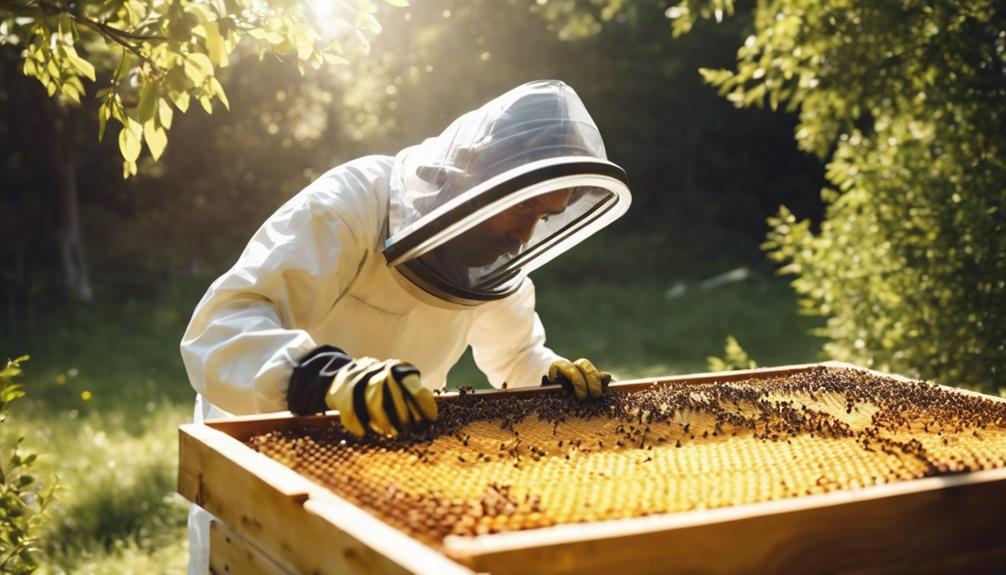
Regular hive inspections play a crucial role in beekeeping by enabling beekeepers to monitor bee health and detect potential issues early on. It’s like a health check-up for our buzzing friends!
- Early Detection: Catching problems early can safeguard the hive from diseases and pests.
- Preventive Measures: Inspections help avert issues that could harm the colony, keeping our bees happy and healthy.
- Compliance: Following inspection guidelines, like the Australian Honey Bee Industry Biosecurity Code of Practice, guarantees we meet legal requirements and maintain hive well-being.
With regular hive inspections, we stay one step ahead, ensuring our bees thrive and our hives remain strong and vibrant. It’s a small time investment that pays off in the long run.
Time Investment for Honey Extraction
When extracting honey, managing the time investment efficiently is essential for beekeepers to streamline their harvesting process. The time spent on honey extraction can vary depending on the equipment and techniques used.
Beginners employing manual uncapping and spinning methods may invest 1-2 hours in this task. For those seeking a quicker process, the innovative Flow Hive extraction method offers convenience with minimal time investment.
Automated equipment is another option that significantly reduces the time required for honey extraction, optimizing efficiency in the beekeeping routine. By adopting efficient honey extraction methods, beekeepers can save valuable time and effort, allowing for a more seamless and productive harvesting experience.
Managing Bee Pests Effectively

To safeguard the well-being of our bee colonies, effectively controlling bee pests is a fundamental aspect of beekeeping practice. In terms of managing bee pests, there are several key strategies that we implement to guarantee the health and productivity of our hives:
- Regular monitoring and treatment for Varroa mites
- Implementing Integrated Pest Management (IPM) techniques
- Maintaining proper hive ventilation and cleanliness
Considerations for Beekeeping Regulations
Adhering to beekeeping regulations is essential for maintaining the health and sustainability of bee colonies. Local regulations play a vital role in beekeeping, often requiring hive registration and compliance with specific codes. These legal requirements not only help prevent the spread of diseases but also safeguard the overall health of the bee population.
Understanding and following these regulations is key for hobbyists to thrive in their beekeeping endeavors. By staying compliant, beekeepers contribute to the maintenance of bee colonies and support the well-being of these essential pollinators. So, while it may seem like a hassle at times, embracing these rules ultimately benefits both the bees and the beekeepers.
Impact of Beekeeping on Neighbors
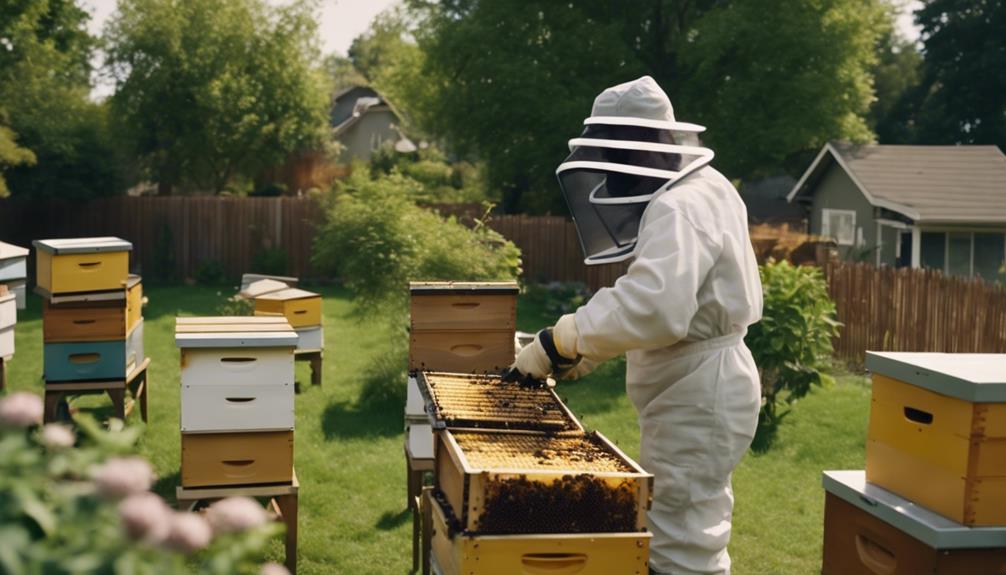
When beekeeping, it’s important to ponder the impact on neighbors. The noise from hives, concerns about bee swarming, and the behavior of honeybees can all influence those living nearby.
Being mindful of these factors and taking steps to address them can help maintain positive relationships with neighbors while enjoying the hobby of beekeeping.
Noise From Hives
Beehives, despite common misconceptions, don’t generate disruptive noise as bees themselves are generally quiet creatures.
- Neighbors usually don’t notice any noise from beekeeping activities.
- Bees’ buzzing is typically only audible within a short distance of the hive.
- Proper hive placement and management strategies can minimize noise concerns for neighbors.
When considering beekeeping and its impact on neighbors, communication is key. Talking to those nearby about your beekeeping practices can help address any worries they may have about noise. By being open and transparent, you can build understanding and potentially even foster an interest in the fascinating world of bees.
Bee Swarming Concerns
Taking proactive measures to prevent bee swarming is essential for maintaining positive relations with neighbors and minimizing disruptions from beekeeping activities. Bee swarming, a natural process, can raise concerns among neighbors due to the sudden presence of buzzing bees.
By implementing effective hive management techniques, beekeepers can address swarming issues before they escalate. Educating neighbors about the reasons behind swarming and how it’s managed can help build understanding and alleviate worries. Open communication and transparency in beekeeping practices foster a sense of community and mutual respect.
Proactively addressing swarming concerns not only fosters harmonious relationships with neighbors but also ensures a peaceful coexistence between beekeepers and the community.
Honeybee Behavior Impact
Understanding honeybee behavior plays an important role in minimizing any negative impacts that beekeeping activities may have on neighbors. Bees forage within a 2-3 mile radius, influencing local nectar sources and enhancing pollination. Well-managed hives lead to docile bees, reducing the likelihood of stinging incidents and promoting harmonious cohabitation.
By educating neighbors on bee habits and benefits, we can cultivate positive community relations, fostering understanding and appreciation for these essential pollinators. Proper hive placement and management techniques are key in mitigating disturbances and ensuring peaceful interactions with neighbors.
When beekeepers prioritize responsible practices and considerate beekeeping methods, it not only benefits the bees but also contributes to a more cohesive and supportive neighborhood environment.
Physical Requirements for Beekeeping
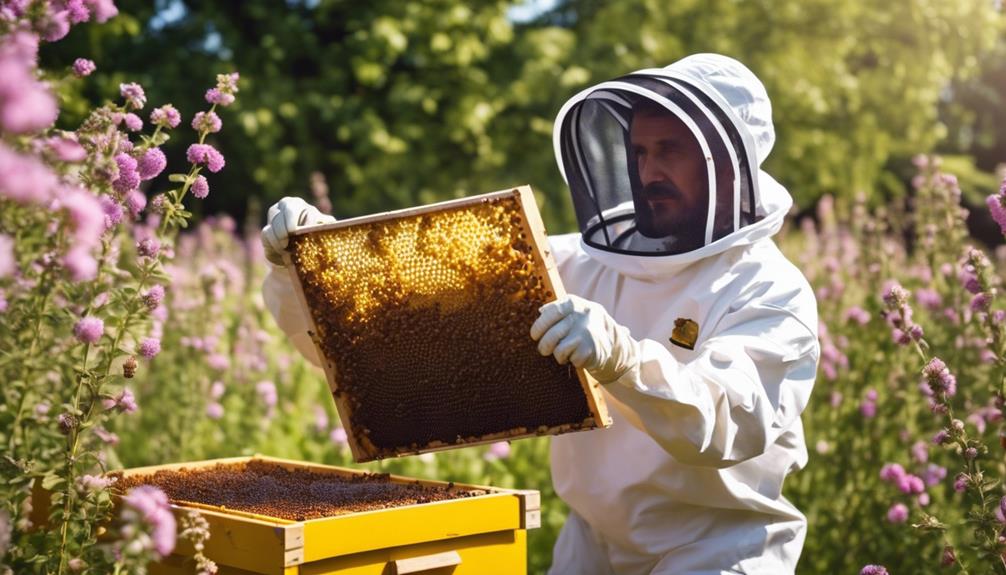
Maintaining physical strength is essential for effectively managing the demands of beekeeping, including handling heavy hive components and conducting thorough inspections while wearing protective clothing. Beekeeping isn’t just a hobby; it’s a physically engaging activity that requires a certain level of fitness.
Protective clothing plays an important role in shielding beekeepers from potential stings during hive inspections, ensuring safety and comfort. By incorporating regular physical activity into your routine, you can gradually build the strength needed for various beekeeping tasks. Remember, using proper lifting techniques is critical to safely handle and move heavy beekeeping equipment without risking injury.
Regarding bee stings, staying calm and moving methodically is key to minimizing disturbances and maintaining a harmonious beekeeping experience.
Financial Aspects of Starting Beekeeping
Starting beekeeping involves an initial investment of around $500 for essentials like hives, bees, tools, protective gear, and gloves.
As beekeepers, we should also consider ongoing expenses for maintenance, workshops or courses, and specialized equipment for hive management.
Exploring potential revenue sources can help offset costs and make beekeeping a sustainable and rewarding hobby.
Initial Equipment Costs
When considering starting beekeeping, one must factor in the initial equipment costs involved. Here are some essential points to keep in mind:
- Initial equipment costs for starting beekeeping typically range around $500 for essentials like hives, bees, tools, protective gear, and gloves.
- Additional investments may be required for extracting tools, treatments for pests and diseases, and spare hive parts.
- It’s recommended to start with at least two hives for comparison and to increase chances of success in beekeeping.
Exploring cost-saving options like building your own hives or capturing swarms can help reduce initial expenses.
Understanding the financial investment involved in beekeeping is pivotal for effective planning and budgeting.
Ongoing Maintenance Expenses
In managing ongoing maintenance expenses for beekeeping, our financial focus revolves around hive inspections, pest management, and disease prevention. These tasks are essential to guarantee the health and productivity of our bee colonies. Regular hive inspections help us monitor the bees’ well-being and catch any issues early on.
Pest management is critical to protect our hives from invaders like mites and beetles. Disease prevention involves proactive measures to keep our bees safe from common illnesses. Investing in beekeeping supplies, such as sugar syrup, medications, and protective gear, is necessary for carrying out these ongoing tasks effectively.
Potential Revenue Sources
Exploring potential revenue sources in beekeeping reveals various avenues for generating income through the sale of honey, beeswax products, and pollination services. Beekeepers can expand their earnings by tapping into different markets and services. Here are some ways to make a buzz with your beekeeping business:
- Selling honey: Harvesting and selling your own honey at local farmers markets or through online platforms can be a sweet source of income.
- Selling beeswax products: Crafting candles, balms, and soaps from beeswax can create a buzz among eco-conscious consumers looking for natural products.
- Pollination services: Offering pollination services to orchards, farms, and gardens can be a fruitful way to boost your revenue while helping crops thrive.
Balancing Time Commitment and Rewards
To maintain a healthy balance between the time commitment required for beekeeping and the rewarding outcomes, consistent dedication to hive maintenance is vital. While beekeeping generally requires minimal time commitment, around 30-45 minutes per hive per week, it’s important to bear in mind that this can vary based on hive activity and honey production periods.
Finding a rhythm that suits your schedule is key to balancing the time invested with the sweet rewards of honey production and the positive impact on the environment. By staying engaged in learning and implementing best beekeeping practices, we can optimize our time and make sure that the time spent with our hives isn’t only fulfilling but also sustainable in the long run.

Roger Thomas is a seasoned beekeeper and hive architect with a deep-seated passion for sustainable living. His fascination with bees has shaped his professional career, giving him practical and theoretical expertise in bee behavior, colony health, and optimal hive conditions. Roger’s technical skills shine in his bespoke hive creations that cater to the specific needs of diverse bee species, while his sustainable practices promote environmental balance and the wellbeing of the bee population.
As he continues his journey in beekeeping, Roger has become a dedicated advocate for responsible practices and an insightful educator in his field. His posts aim to inspire new beekeepers, underline the importance of sustainability, and showcase the remarkable contribution bees make to our ecosystem. Roger invites you to join him as he delves into the world of bees and the rewarding, honey-sweet art of beekeeping.
